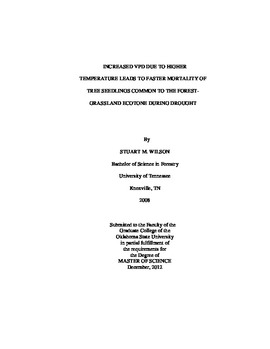| dc.contributor.author | Wilson, Stuart Mars | |
| dc.date.accessioned | 2014-04-15T22:00:04Z | |
| dc.date.available | 2014-04-15T22:00:04Z | |
| dc.date.issued | 2012-12-01 | |
| dc.identifier.uri | https://hdl.handle.net/11244/9204 | |
| dc.description.abstract | My objective was to assess the effects of an increase in VPD on plant water use strategy, seedling establishment, and persistence of multiple species common in Oklahoma along the forest-grassland ecotone under predicted climate change conditions. We tested seedlings of ten species, post oak (Quercus stellata), Shummard Oak (Quercus shumardii), bur oak (Quercus macrocarpa), redbud (Cercis canadensis), American plum (Prunus americana), persimmon (Diospyros virginiana), eastern redcedar (Juniperus virginiana), hackberry (Celtis occidentalis), mulberry (Morus rubra), and sycamore (Platanus occidentalis), to see if a 3C increase in temperature and a 3C decrease in dewpoint during a time of drought would increase water use and hasten mortality. To test the effects of temperature, we exposed seedlings to day/night temperature regimes of 30/25C and 33/28C while maintaining a dew point of 21C at all times by controlling relative humidity. To test the effect of dewpoint, we held a constant temperature of 30/25C (day/night) and varied the relative humidity to create a day-time dewpoint of 21C (59% RH) and 24C (70% RH). These temperature/humidity combinations resulted in a constant day-time dewpoint of 21C with a VPD of 1.74 kPa, for the temperature study and day-time dewpoints of 24C (VPD of 1.26 kPa) and 21C (VPD of 1.74 kPa) for the humidity study. These treatments resulted in a 45% higher day-time VPD in the 33/28C chambers in the temperature study and a 27% higher day-time VPD in the humidity study. The higher VPD in each study lead to a significantly greater transpiration rates in all trees in this study. Water potential was also significantly more negative in the non-watered trees grown at a higher temperature but not at the lower dewpoint. Mortality was significantly hastened by the increase in VPD with increased temperature but not with decreased dewpoint. These results indicate that additional water stress along with increased VPD during prolonged drought periods and increased temperatures consistent with climate change scenarios may lead to large shifts in tree species distribution along the forest-grassland ecotone of the central United States. | |
| dc.format | application/pdf | |
| dc.language | en_US | |
| dc.publisher | Oklahoma State University | |
| dc.rights | Copyright is held by the author who has granted the Oklahoma State University Library the non-exclusive right to share this material in its institutional repository. Contact Digital Library Services at lib-dls@okstate.edu or 405-744-9161 for the permission policy on the use, reproduction or distribution of this material. | |
| dc.title | Increased Vpd Due to Higher Temperature Leads to Faster Mortality of Tree Seedlings Common to the Forest-grassland Ecotone During Drought | |
| dc.type | text | |
| osu.filename | Wilson_okstate_0664M_12498.pdf | |
| osu.college | Agricultural Sciences and Natural Resources | |
| osu.accesstype | Open Access | |
| dc.description.department | Department of Natural Resource Ecology and Management | |
| dc.type.genre | Thesis | |
